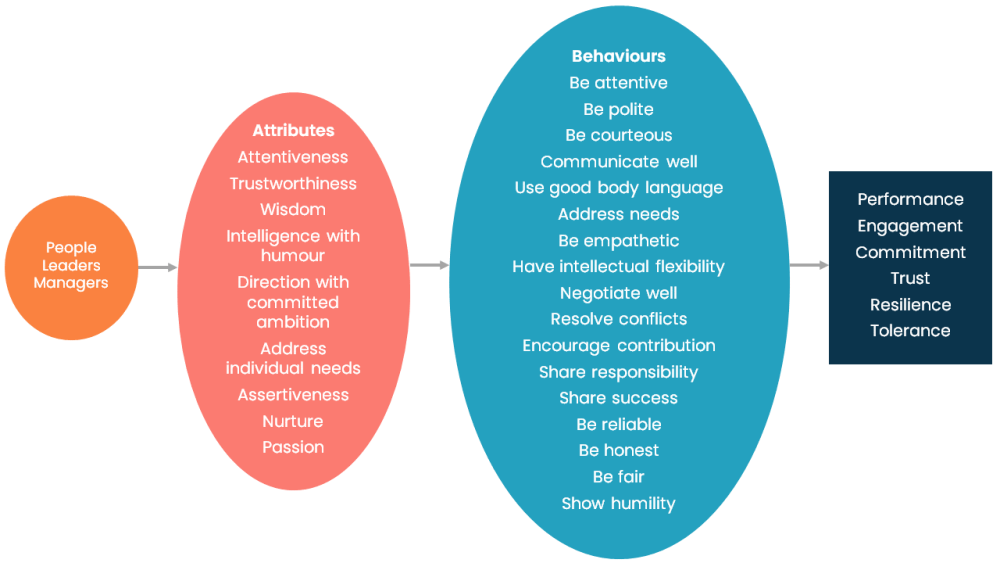Leader and manager’s role in resilience
There are two roles for leaders and managers acting as leaders in resilience
- Preventing the need for their teams to call on their resilience, and
- Helping team members strengthen their personal resilience against challenging events and behaviours
Resilience comes from having robust attitudes towards challenges that are perceived as threatening. The more robust the attitude, the more likely the person is to have a ‘will do’ approach to facing up to the challenge and addressing it without difficulty.
The focus for managers acting as leaders is on preventing the need for their teams to call on their resilience because there are no challenging and difficult events and behaviours for which resilience is required.
Managers acting as leaders at all levels of the organisation set the tone, the climate and the expectations for the workforce. They control a controlled community that we call the workplace. Managers wield enormous power over others. They can prevent the need for their teams to call on their personal resilience. It is a matter of attitude and knowing what to do.
To understand their role in resilience, leaders and managers acting as leaders need to
- Understand resilience and what makes people have to call on their resilience
- Learn the triggers and techniques for helping to prevent the need for people to call on their resilience, and
- Understand how to help their teams strengthen their personal resilience.
The rationale is, if a manager understands the psychology of what makes people resilient, they will be able to help their people with techniques to reduce stress and strengthen resilience. More importantly, they will apply processes and techniques that ensure their people have few reasons to call on their own personal resilience in the first place.
There are five actions for managers to strengthen the resilience of their workforce
- To prevent the events and behaviours which may trigger distress in others, and for which resilience is needed.
- To provide the working environment that stimulates individuals to perform consistently at their peak.
- To behave and act in ways that helps the workforce form strong and positive attitudes towards you as a manager.
- To help develop the resilience in individuals through exposure to challenging and varied events, which individuals can rise to, cope with and grow, thus adding to their portfolio of experiences that they know they can deal with if experienced again in the future.
- Provide training and development programmes on strengthening personal resilience
Exercise
Let’s look at some examples of events and behaviours which cause an adverse reaction and trigger stress in others. These behaviours arise in organisations that do not have a positive working environment.
Review this list and see if you recognise any in your own organisation. Challenge yourself about the part of the organisation that you manage and reflect on the behaviour of your own workforce to see if they show any of the characteristics above.
- Inconsistent leadership, for example, leaders demonstrating double standards
- A lack of engagement between the workforce and the organisation - no sense of kinship, identity or attachment.
- Lack of interest in the workforce – no sense of the workforce being valued
- Excessive time spent on rumour and gossip demonstrating a lack of trust.
- Intolerance of diversity, equality and inclusion.
- A significant proportion of poorly performing managers and employees without anyone in authority taking notice (because that is the cultural norm).
- Passive aggression (people talking unsympathetically and belligerently behind backs).
- The lack of any ethical behaviour towards the workforce and clients (not treating people fairly and with objectivity).
- Undisciplined behaviour in the workplace.
- Core values that are not applied in practice.
- Use of intimidation, coercion and bullying to get things done.
- Cutting corners and being rewarded for doing so.
- Operating on a ‘need to know’ basis (being secretive about what is going on in the organisation).
- A culture of blame (blaming others for their mistakes).
- Rigidity (never allowing variations in work patterns to meet individual requirements).
- Relentless demands on people’s time (constant work demands leading to overwork, short cuts and poor quality).
- Unrealistic targets (set by people who have never done the job and beyond the possibility of being achieved without short cuts and excessive time).
- Tick box approach to many key issues (which squeezes out any possibility of in depth study of complex issues and their solution).
- Quick fix atmosphere (that squeezes out any possibility of tackling complex issues in any way other than superficially).
- Inconsistent approaches by managers (eg different managers deal with similar problems in different ways).
- Suppressed observations (preventing the workforce from making public or private comment about the organisation).
- An obsession with money.
- Regular organisational changes without explanation and implemented in great haste.
- Poor change management (lack of communication, lack of explanation).
- Ambiguity about what the organisation stands for.
- Treat people who blow the whistle on poor performance as pariahs.
Discuss the statements with your own staff.
To change things around and develop a positive working environment with triggers that prevent events and behaviours for which resilience may be required, it is best starting with the behaviours of leaders and managers.
People need leaders; processes need managers
This is a people issue, so the focus needs to be on transforming managers into leaders, and for leaders to acquire and embed attributes, attitudes and approaches that produce behaviours that prevent adverse events and difficult behaviours. Some of the attributes and behaviours required are shown in the image below.
Attitudes and behaviours for the manager's role in resilience
The aim for managers acting as leaders is to achieve in each person Mowbray’s Mantra – for people to feel empowered; encouraged; engaged and enjoyment at work.
If managers acting as leaders can achieve these in their workforce, they will have created the working environment that provokes people to feel psychologically well and able to overcome challenging and difficult events and behaviours without experiencing any diminution in their performance.

This article and accompanying tips have been provided for FICM by leading psychologist Dr Derek Mowbray.
To find out more about Strengthening Organisational Resilience, read Derek ’s Guide to Organisational Resilience.
To find out more about in house programmes for Organisational Resilience, email barbara.leigh@mas.org.uk, or download a pdf of all our development programmes.
More information can be found in the MAS Article Library, or why not try the MAS Questionnaires.
Want to know more?
Browse our Wellbeing resources.


